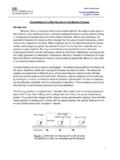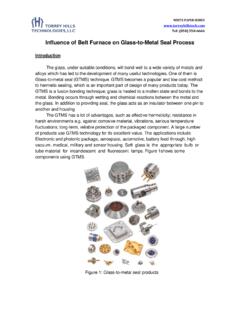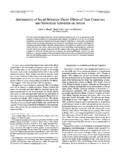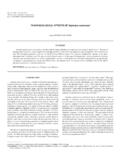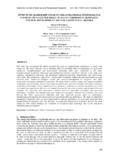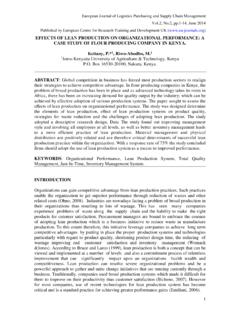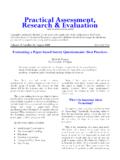Transcription of Stellar Direct Bond Copper Technologies Article
1 Direct bond Copper (DBC) Technologies By Ron Visser & John B. Snook Stellar Industries Corp. 50 Howe Avenue Millbury, MA 01527 (508) 865 1668 INTRODUCTION Direct bond Copper technology that primarily uses Copper foil bonded directly to ceramic substrates was originally developed and patented by General Electric Company in the early 1970 s and subsequently protected with a series of other patents. Although jewelry makers in fabrication of Copper costume jewelry for many years have practiced a similar process, GE was able to patent the technology for its application to ceramics.
2 The technology, which required royalty licensing, offers advantages over traditional thick and thin film metalization Technologies for a wide range of modern microelectronic applications. The inherent advantages of using bulk metal Copper foil in place of fritted or reactively bonded pastes and economically expensive sputtered metalizations is increasingly finding wide ranging applications across the span of military, commercial, industrial, and automotive industries as engineers readily accept the electrical and thermal properties of a traditionally favorite Copper system for electronic circuits.
3 The standard Direct bond Copper or DBC technology which uses Copper foil thicknesses in the range of to inches is usually specified for high power and high thermal management circuits where the large geometry requirements of inch wide lines and spacings can be used. New processes and additional refinements of the process which adapt the inherent advantages of the strong bonding mechanism of the DBC process however, will allow the technology to be adapted for fine line circuitry and will extend its applications to high frequency circuits.
4 DISTRIBUTED DBC PROCESS The DBC process uses OFHC (oxygen free) or ETP (tough pitch) Copper foil which has been oxidized by chemical or thermal means to provide a uniform dark blue-gray CuO cupric oxide coating thickness, on the Copper surface. This foil is placed on the face of an oxide ceramic such as alumina or beryllium oxide and introduced through an inert tunnel furnace, which is usually continually purged with nitrogen.
5 >From the phase diagram reproduced from an early GE patent 3,994,430 (Figure 1), it is evident that a liquidus region at 1 .54 atomic percent oxygen exists at 1065 C. The belt furnace is profiled in a high peaked bell shape thermal distribution to bring the Copper and ceramic to a temperature above the 1065 C eutectic bonding temperature at which the Copper oxide forms a liquidus cuprous oxide (Cu20) matrix which wets and chemically bonds to the oxide surface of the ceramic.
6 Since the eutectic temperature is 18 C below the 1084 C melting point of pure Copper , the furnace profile must be tightly controlled to overcome loading- effects from both- the mass of the entering substrates and the cooling effects of the nitrogen gases. The resultant bond is highly tenacious and rugged. With alumina and beryllium oxide surfaces bond strengths exceeding 24,000 PSI are readily achieved. The conversion of the initial cupric oxide (CuO) formed on the Copper and the resulting cuprous oxide (Cu20) - Copper bond releases excess gas during the process which must be dissipated from the Copper - ceramic interface to avoid gaseous entrapments under the Copper which appear as blisters.
7 These blisters which are normally referred to as tents to distinguish them from reliability problems associated with thin film blistering and plating blistering, are a commonplace phenomena and is one of the highest yield point losses in the process. This problem is also compounded as the area of the bonded surface increases to the large alumina Herman ( x ) and super Herman ( x ) sizes. To overcome this problem, the majority of DBC processes use Copper foil that has been pre-etched on one side with a pattern of evenly spaced parallel grooves which when placed against the ceramic allow the dissipation of the gas during the eutectic formation preventing gas entrapment until the grooves become filled with eutectic themselves.
8 Different vendors vary groove patterns and depths to optimize this technique for their oxidization process. These grooves although solving one problem leads to other subsequent process problems such as chemical entrapment during chemical etching, cleaning, or soldering processes; ceramic staining due to chemical entrapment during soldering or heat baking and; severe undercutting for fine line circuit patterns. They can also become a source for moisture entrapment during environmental screening which can lead to a rupture of the Copper to ceramic bond during temperature cycling and thermal shock conditions.
9 More modern techniques allow control of the oxide thickness to eliminate the grooves from the Copper foil completely too totally eliminate these, problems. After the bond is formed the Copper and ceramic is slowly cooled in the furnace to temper the Copper foil to a dead-soft annealed condition and to control the Copper grain formation. Excess oxygen and high temperatures can lead to a roughened alligator type skin condition due to high eutectic oxide segregating at the Copper grain boundaries.
10 This condition can result in an uneven surface texture and extensive nodule formation, which may disturb chip attachment and wire bonding. The annealing of the Copper during its cool down phase is important to overcome the severe thermal expansion DISTRIBUTED mismatches of the Copper and ceramic. Once bonded at DBC temperatures above 1065 C, the large temperature differential to room temperature can lead to severe bowing and camber of the ceramic as the Copper contracts at a faster rate.
